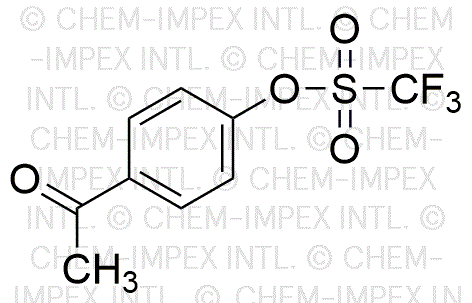4-Acetylphenyl trifluoromethanesulfonate is widely utilized in research focused on:
- Organic Synthesis: This compound serves as a versatile reagent in organic synthesis, particularly in the formation of complex molecules. Its trifluoromethanesulfonate group enhances reactivity, making it valuable for chemists looking to create new compounds efficiently.
- Pharmaceutical Development: In the pharmaceutical industry, it is used to modify drug candidates, improving their bioavailability and therapeutic properties. Researchers can leverage its unique structure to develop more effective medications.
- Material Science: The compound plays a role in the development of advanced materials, such as polymers and coatings. Its chemical properties allow for the creation of materials with enhanced durability and resistance to environmental factors.
- Analytical Chemistry: It is utilized as a derivatizing agent in analytical chemistry, aiding in the detection and quantification of various compounds. This application is crucial for quality control in laboratories and industries.
- Environmental Applications: Researchers are exploring its potential in environmental science, particularly in the treatment of pollutants. Its ability to react with certain contaminants can help in developing methods for remediation.
General Information
Properties
Safety and Regulations
Applications
4-Acetylphenyl trifluoromethanesulfonate is widely utilized in research focused on:
- Organic Synthesis: This compound serves as a versatile reagent in organic synthesis, particularly in the formation of complex molecules. Its trifluoromethanesulfonate group enhances reactivity, making it valuable for chemists looking to create new compounds efficiently.
- Pharmaceutical Development: In the pharmaceutical industry, it is used to modify drug candidates, improving their bioavailability and therapeutic properties. Researchers can leverage its unique structure to develop more effective medications.
- Material Science: The compound plays a role in the development of advanced materials, such as polymers and coatings. Its chemical properties allow for the creation of materials with enhanced durability and resistance to environmental factors.
- Analytical Chemistry: It is utilized as a derivatizing agent in analytical chemistry, aiding in the detection and quantification of various compounds. This application is crucial for quality control in laboratories and industries.
- Environmental Applications: Researchers are exploring its potential in environmental science, particularly in the treatment of pollutants. Its ability to react with certain contaminants can help in developing methods for remediation.
Documents
Safety Data Sheets (SDS)
The SDS provides comprehensive safety information on handling, storage, and disposal of the product.
Product Specification (PS)
The PS provides a comprehensive breakdown of the product’s properties, including chemical composition, physical state, purity, and storage requirements. It also details acceptable quality ranges and the product's intended applications.
Certificates of Analysis (COA)
Search for Certificates of Analysis (COA) by entering the products Lot Number. Lot and Batch Numbers can be found on a product’s label following the words ‘Lot’ or ‘Batch’.
*Catalog Number
*Lot Number
Certificates Of Origin (COO)
This COO confirms the country where the product was manufactured, and also details the materials and components used in it and whether it is derived from natural, synthetic, or other specific sources. This certificate may be required for customs, trade, and regulatory compliance.
*Catalog Number
*Lot Number
Safety Data Sheets (SDS)
The SDS provides comprehensive safety information on handling, storage, and disposal of the product.
DownloadProduct Specification (PS)
The PS provides a comprehensive breakdown of the product’s properties, including chemical composition, physical state, purity, and storage requirements. It also details acceptable quality ranges and the product's intended applications.
DownloadCertificates of Analysis (COA)
Search for Certificates of Analysis (COA) by entering the products Lot Number. Lot and Batch Numbers can be found on a product’s label following the words ‘Lot’ or ‘Batch’.
*Catalog Number
*Lot Number
Certificates Of Origin (COO)
This COO confirms the country where the product was manufactured, and also details the materials and components used in it and whether it is derived from natural, synthetic, or other specific sources. This certificate may be required for customs, trade, and regulatory compliance.


